Listen to This Article:
What drives a successful food blogger, cookbook author, and culinary class instructor back to the classroom?
For Escoffier student Amy Kimoto-Kahn, it’s more than just perfecting her craft—it’s about preserving her Japanese heritage and creating a deeper connection through food. Growing up, Amy learned that food is more than something we eat; it’s an experience and a way to learn about and honor different cultures. While she’s faced obstacles in her culinary journey, her resiliency and passion for sharing her Japanese heritage with future generations can’t be stopped.
Though she’s already achieved so much, Amy sees culinary school as the next step in a journey defined by resilience, passion, and an unbreakable commitment to her cultural roots.
Read on to discover how Amy’s perseverance and cultural pride have led her to achieve her culinary dreams.
Family Legacy and Cultural Pride
To understand Amy’s culinary journey, it’s important to first explore the rich history and resilience of her family. Amy grew up in a Japanese-American family that faced and overcame WWII internment. Her parents and their families were falsely accused of being Japanese spies during the war despite her parents being third-generation Japanese Americans.
They lost everything, including their businesses, and had to start over and rebuild once they were released two years later. Their actions and resiliency set an example for Amy in perseverance and preserving traditions that still drive her to this day. “Nothing just comes to you,” she shares from what she learned from her family. “You have to go for it.”
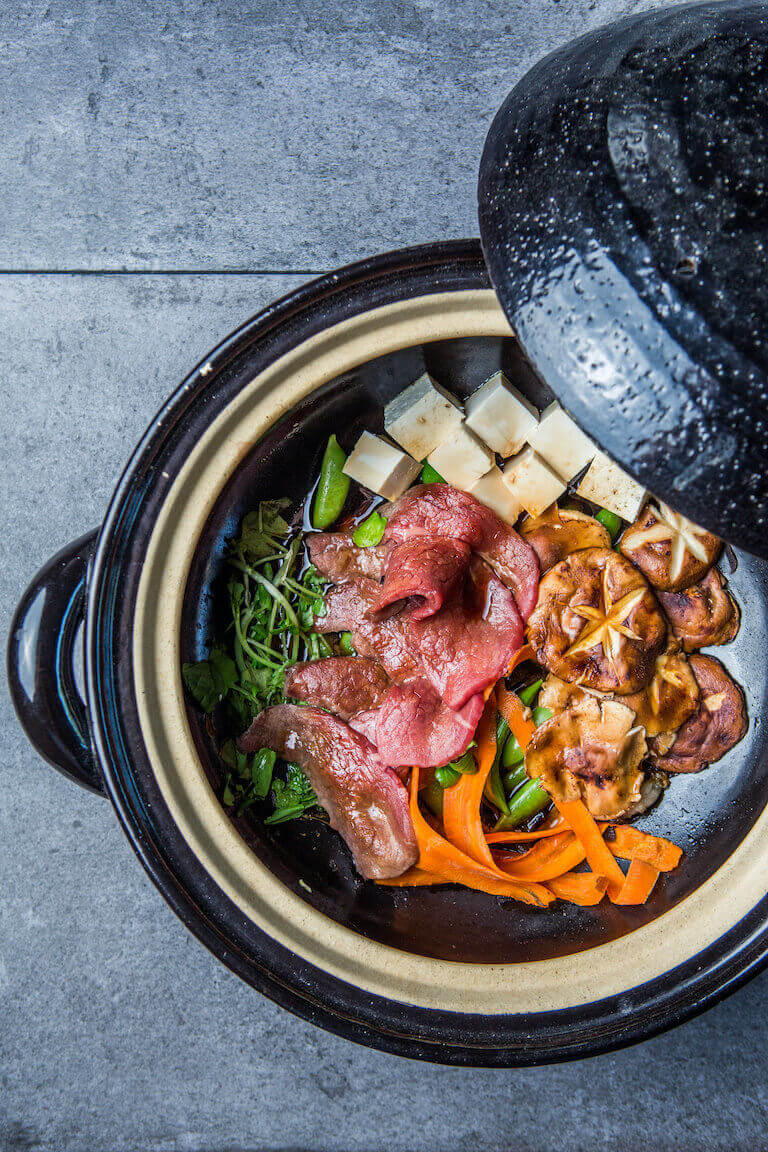
Amy Kimoto-Kahn’s Kobe beef shabu-shabu.
Her mother remembers the years after the war when money was tight. They grew fresh vegetables in the garden to get by and her mother learned how to cook and stretch food out for days, often making fried rice, considered a Japanese peasant dish cooked from leftovers.
Developing a Passion for Cooking at an Early Age
Amy’s mom carried her passion for cooking into her own home, teaching Amy how to cook from a very early age. At the age of five, she would wash rice, and not long after she learned how to cut alongside her knuckles with sharp knives to protect her fingers.
But the cooking lessons extended beyond the taste of the food. In Japanese culture, the presentation of food is just as important as the taste. Amy remembers watching her mother carefully plate each dish, making sure there weren’t multiple foods of the same color on the plate. She would ask Amy to run outside to collect a fern or flower to garnish the plates, reminding her that, “If it’s not pleasing to the eye, it’s not worth serving.”
It wasn’t only Amy’s mother who made a lasting impact; her mother’s group of friends, The Dames, also set an example that has been a driving force for Amy to this day.
Learning to Transform Meals into Cultural Celebrations with “The Dames”
Amidst the backdrop of post-war prejudice, Amy’s mother and her friends created a community of strength and celebration through food. As young adults, her parents weren’t allowed to join sororities or fraternities at their university. But following the family story of resilience, her mother found a way to create her own space alongside a group of Japanese-American friends. They called themselves The Dames and made a name for themselves by hosting elaborate themed dinner parties.
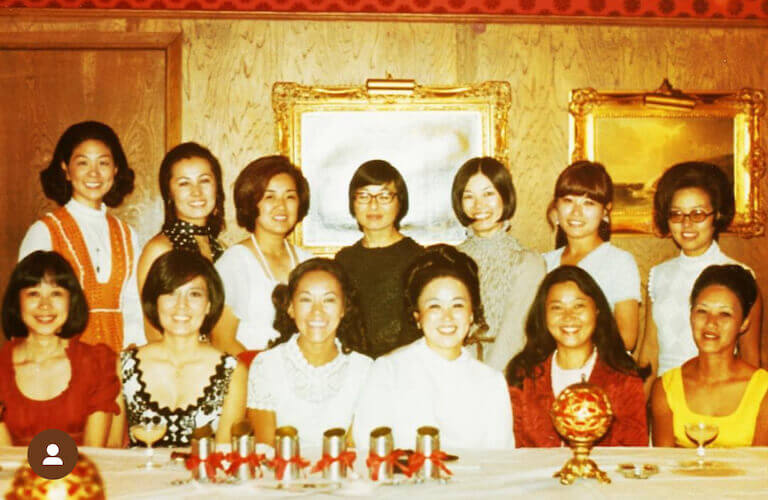
The Dames played a pivotal role in forming Amy’s passion for cooking and hosting.
They were about much more than cooking. They used food as a way to both honor their heritage and share it with others. While they compiled their recipes into a cookbook that is still sold in the gift shop of the Japanese American National Museum in Los Angeles, they were gifted at elevating the dining experience.
These gatherings required meticulous preparation, and as the years went by, The Dames enlisted their children, including Amy, to help. For Amy, helping at these dinners planted the seeds for her love of hosting and sharing her culture through the culinary experience. Through this experience, Amy learned not just how to cook, but how to transform a meal into an experience. Watching The Dames work was a powerful inspiration that shaped her approach to food and hospitality, values that she carries with her to this day.
The Journey to a Published Cookbook
Amy’s time spent in the kitchen, helping her mom and “aunties” with their dinner parties, sparked the dream of authoring her own cookbook one day. While she didn’t immediately pursue it, the idea lived in the back of her mind and she began finding other ways to share her cooking and culture with others.
“As a young adult living in San Francisco, California, I was constantly surrounded by good food,” Amy explains about her start to cooking for others. “San Francisco is and was such a culinary mecca with a bevy of restaurants that can give you anything your heart desires when it comes to food and global cuisine.” Her friends enjoyed trying all the new food locations, and Amy began inviting them over to cook for them.
However, cooking for friends as a young adult in San Francisco was more than just sharing a meal—it was Amy’s way of sharing her culture. Whether it was her signature sweet chili salmon or Furikake Arare, she loved hosting and experimenting with Japanese flavors. This passion ultimately led to her friends encouraging her to start her blog, Easy Peasy Japanesey.
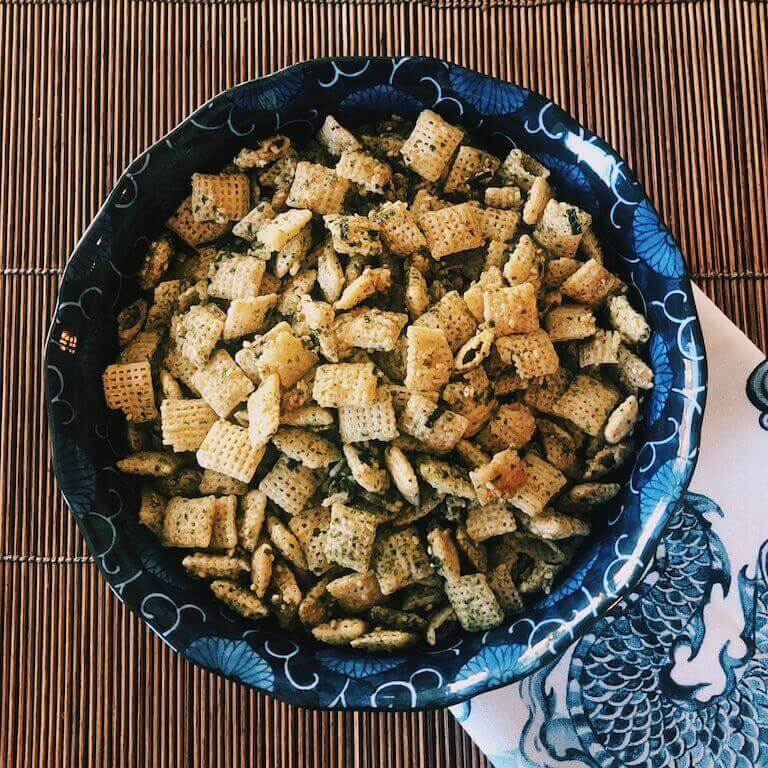
Amy enjoys preparing Japanese-inspired meals and snacks for her friends, like Furikake Arare.
While she was interested in pursuing a culinary career, she was afraid to quit her corporate career, so the blog was a way for her to take a first small step. It’s become a place where she shares her food travels, family traditions, and new recipes with the world.
Years later, after leaving the corporate world, getting married, starting a family, and living abroad, Amy’s desire to author a cookbook remained strong, and she was ready to push forward to make it happen. She started working at Pottery Barn Kids, where she noticed the same editor appearing in many different cookbooks. So, she decided to cold-call the editor and share her idea of writing a cookbook to share her family recipes. This bold move was a reflection of Amy’s perseverance—she was willing to take risks and step outside her comfort zone to pursue her passion.
The editor’s response surprised them both. She told Amy that she wasn’t sure why she wanted to help her, but if she were willing to be patient, she would take her on as a pro bono account. Over the next four years, they wrote a proposal and eventually connected with a cookbook packager who gave her one year to make it work. She introduced her to publishers, and they found one who was interested but not exactly the way Amy had planned.
Mastering Ramen: An Unexpected Twist
Ramen was becoming a really popular Japanese dish in America, so the publisher asked Amy to write a ramen cookbook instead of one with family recipes. Initially, she was hesitant. This wasn’t the story she had imagined telling, but Amy believes in making the most of the opportunities that come your way. The challenge was that she wasn’t a ramen expert.
Ramen is an art that requires time and attention to master, and Amy knew that achieving excellence would not be easy. “In order for a bowl of ramen to be good, it has to have the right texture of noodles. It has to have a broth or soup that’s flavorful and layered,” Amy explains. “It has to have all the different toppings that make sense for it, and are each individually made, with care. So, in order to have a whole bowl that is good with all of those components, is very difficult.”
However, she was determined to overcome her lack of expertise and knew she had to learn from the best. So, she decided to immerse herself in the craft by flying to Osaka, Japan, where she could learn directly from a ramen master.
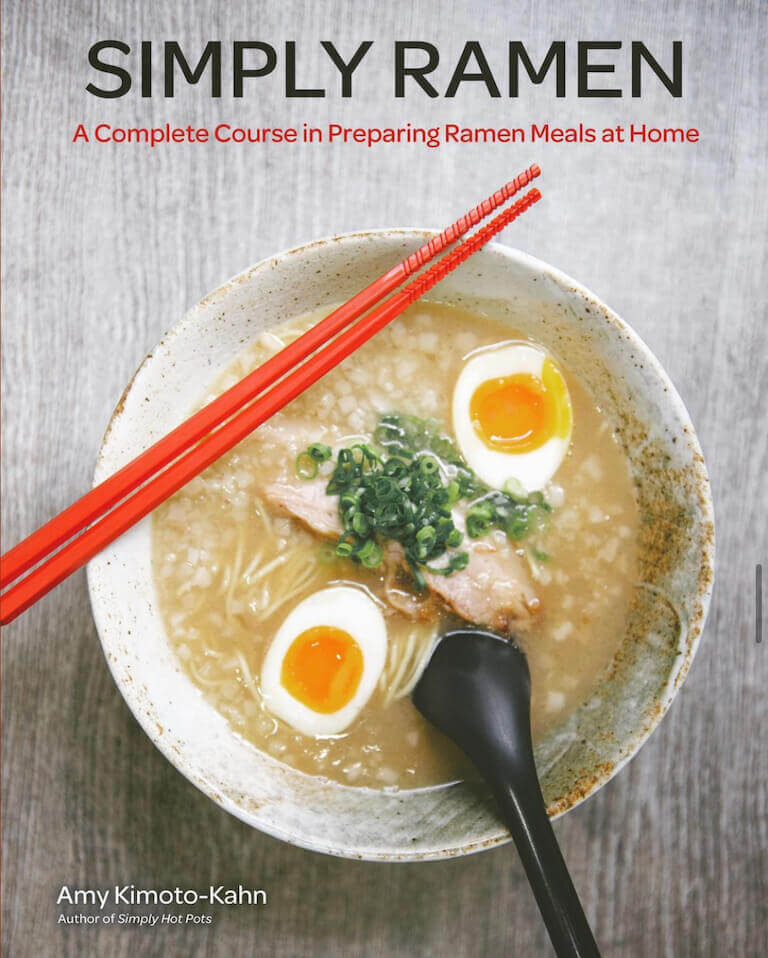
Amy achieved her dream of publishing a cookbook. Her first was called Simply Ramen and she has since published The Asian Hot Pot Cookbook.
Amy’s commitment to authentically represent ramen speaks volumes about her dedication and perseverance. She took on the challenge, learned from an expert, and ultimately succeeded in publishing not just one but two cookbooks: Simply Ramen: A Complete Course in Preparing Ramen Meals at Home and The Asian Hot Pot Cookbook: Family-Friendly One Pot Meals.
Becoming a Culinary Influencer and Personal Chef
In addition to writing cookbooks and teaching culinary classes, Amy had the opportunity to teach a cooking class at Google, which led to her introduction to Bon Appétit Management. She was able to work with them to showcase Asian culture and cuisine during Asian American, Native Hawaiian, and Pacific Islander Heritage Month. This was more than just a professional opportunity—it was a way for her to celebrate and share her heritage on a broader platform. She took great pride in being able to represent the Asian community through her cooking.
Amy’s journey also led her to work as a private chef for professional athletes, an opportunity that demanded adaptability and high standards. Despite the challenges of meeting the expectations of elite clients, Amy’s dedication to her craft and her perseverance allowed her to thrive in this role, too.
However, even with her extensive culinary resume, an obstacle still blocked her culinary career path.
Why Enroll in Culinary School?
Surprisingly, Amy was passed over for two jobs teaching cooking classes despite her experience. It was a challenging moment for her to face. Despite her accomplishments, she was told that a lack of formal culinary training stood in her way. Acting on the perseverance passed down from her family, she wasn’t about to let that be the end of her culinary journey.
Amy began researching culinary schools. Through her research, she discovered the culinary arts program at Escoffier, which became her first choice. It just so happened that she lived close to the Boulder campus, so she enrolled. Just as her grandparents and parents rebuilt their lives after losing everything, she was determined to rebuild her skillset and embrace formal culinary training.
While Amy is only partially through the courses to earn an Associate’s Degree, she’s gained a new understanding of why she was passed over for the previous teaching positions. “I get why someone would want to hire someone that knows all of the French cooking basics – the mother sauces, the formal names of all of the equipment and names of different knife cuts, and the kitchen brigade system that Escoffier perfected – all of those things are important to know and understand.”
Beyond obtaining a degree to continue with her career goals in the culinary world, Amy enjoys the education process. The class she’s looking forward to the most is World Cuisine because she believes traveling and trying new food from different cultures creates a bond between strangers to help them become new friends. Food draws people together and is a fun way to experience different cultures, which is one reason Amy loves sharing her Japanese recipes with others.
Sharing Her Japanese Heritage Through a Unique Experience
While Amy is excited for her upcoming externship as part of the associate’s degree program, she’s already working on what comes next. Her dream is to open a high-end Japanese specialty store, blending her love of Japanese cuisine with artisanal pottery, cookware, and ready-to-eat meals.
“I want it to be a place where people come to learn about my culture and can take the best of it home with them to share with their family and friends,” she explains. “And I think I’ll call it Easy Peasy Japanesey.”
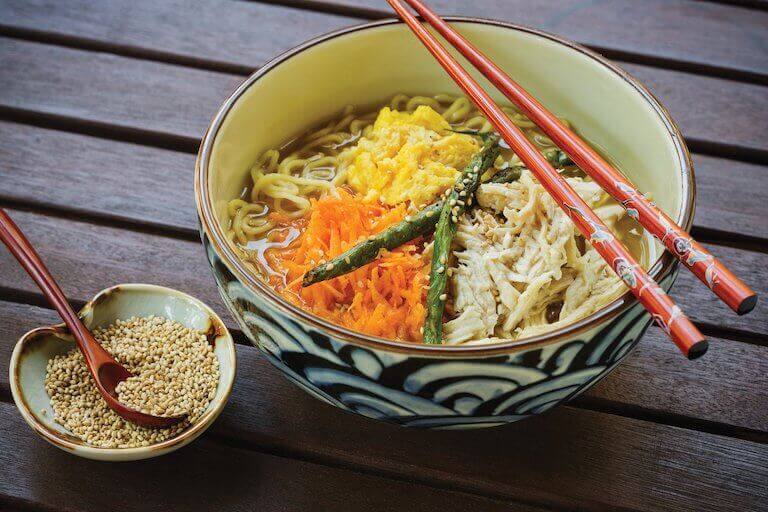
Ginger Chicken Ramen is a dish highlighted in Amy’s cookbook, Simply Raman.
The store would offer the best rice cookers, rice bowls, soy sauce vinegars, soju, sake, and whiskies. It would also have a knife section with an on-site sharpener and a ready-to-eat section with bento boxes, chicken karaage, and onigiri. Children could enjoy sweets and crackers, and a dehydrated ramen bar would be available, with farm-to-table ingredients and homemade bouillon.
The Drive to Succeed
Life is full of challenges, great and small, but they don’t have to stop us from pursuing and achieving our dreams. From flying to Japan to learn from a ramen master to enrolling in a culinary degree program at Auguste Escoffier School of Culinary Arts, Amy is intent on overcoming the obstacles that arise on her culinary journey. She drew on the strength and example her family set for her to keep pushing forward despite difficult and challenging circumstances.
Their example continues to drive her forward in her culinary goals today. She’s determined to build her own path in the culinary world and share her family’s legacy with the community—near and far. Amy desires to encourage others to pursue their dreams as well. When asked what message she wants others to hear and remember, she said, “Don’t be afraid to dive into something that you’re uncomfortable with.”

